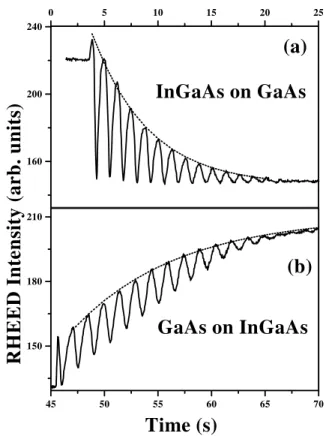In-situ Determination of Indium Segregation in
InGaAs/GaAs Quantum Wells Grown by
Moleular Beam Epitaxy
S. Martiniand A.A. Quivy
InstitutodeFsiadaUniversidadede S~ao Paulo,Laboratorio deNovosMateriais Semiondutores,
CP66318, 05315-970S~aoPaulo,SP, Brazil
Reeivedon23April,2001
Thesurfaesegregation ofindiumatomsduringthegrowthofInGaAs/GaAsheterostrutureshas
beeninvestigatedin situby reetionhigh-energy eletrondiration(RHEED).We pointedout
thatthestrongdampingoftheRHEEDosillationsduringthedepositionofInGaAsonGaAswas
relatedtothesegregationstrengthofindiumatomsintheInGaAslayer. Asimplemodelshowsthat
thedeayonstantoftheRHEEDosillationsmaybeusedtodetermineauratelythesegregation
oeÆient R,asonrmedbyphotoluminesene(PL)measurements.
I Introdution
Sineitsdisovery[1,2℄,surfaesegregationin
III-V semiondutor alloys has been the subjet of
nu-merous studies, in partiular in InGaAs/GaAs
quan-tum wells (QWs) [3, 4℄ beause of their importane
to theoptoeletronis and mirowaveindustries. It is
nowwellestablishedthatsegregationrepresentsthe
ul-timate limitation to obtainperfetly abrupt interfaes
neessary for the prodution of high-performane
de-vies [5℄. This phenomenon has already been
investi-gated by various surfae-sensitivemethods suh as
x-rayphotoeletronspetrosopy(XPS) [6℄, Auger
ele-tron spetrosopy (AES) and RHEED [7, 8℄, ormore
indiretly throughthetof QWoptial-transition
en-ergies from omposition-prole models [3℄. However,
untilnownoneofthephysialtheoriesreportedin the
literature was able to explain the origin of the eet
in asatisfatorywayforallthedierentmaterialsand
systemsinvestigated.
Inthiswork,weproposeasimpleandveryeÆient
wayto determine,insituand inreal time,thesurfae
segregationofindium(In)atoms duringthegrowthof
InGaAs layersonGaAs(001)substrates. Ourmethod,
thatisbasedontheinterpretationoftheintensity
vari-ationoftheRHEEDosillations,diersfromtheother
fewRHEEDstudiesbythefatthattheyonlyprovide
qualitativeresults[7℄orarerestritedtoaspei
ma-terialor growthtehnique[8℄.
II Experimental Details
Thesampleinvestigatedherewasgrownin aMod.
Gen. II moleular beam epitaxy (MBE) systemfrom
Varian and onsisted of a 0.25m-thik GaAs buer
grown at 570 o
C and a QW struture grown at 520
o
C.AftertheGaAsbuerlayer,thesubstrate
temper-ature was ramped up to 610 o
C during 2 minutes to
smooth the GaAs surfae and then ramped down to
520 o
C to deposit the 50
A-thik In
0:14 Ga
0:86
As layer.
Agrowthinterruptionof20swasrealizedattheseond
interfaeand, nally, a50
A-thik GaAs layerwas
de-posited at520 o
C,followedby450
AofGaAsgrownat
570 o
C. Thegrowthratesof thematerialswere
deter-minedby RHEED measurements that yielded avalue
of0.79and 0.68monolayerperseond (ML/s) forthe
In
0:14 Ga
0:86
AsandGaAslayers,respetively. The
sam-plewasnotrotatedduring thegrowthofthestruture
inordertoallowRHEEDmeasurementsduringthe
de-positionoftheInGaAslayerandtheseondGaAs
bar-rier. TheRHEEDmeasurementswerearriedoutwith
a8kVeletrongunand aglaning angleof 1.0 o
along
the[110℄diretionoftheGaAs(001)surfae. Afterthe
growth, thesample wasanalyzed by PL spetrosopy
at1.4Kusingonventionallok-intehniques,aooled
GaAsPhotomultiplier andthe 5145
Aline of anargon
laser.
III Results and Disussion
0
5
10
15
20
25
30
35
40
45
90
100
110
120
130
140
150
GaAs on GaAs
R
H
E
E
D
In
ten
sity
(arb
. u
n
its)
Time (s)
Figure1. TypialRHEEDosillationsduringthedeposition
ofGaAsonaGaAs(001)substrateat570 o
C.
Sine,underonventionalgrowthonditions,
homoepi-taxy proeeds in the layer-by-layer growth mode, the
osillationsareusuallyexplainedintermsofthe
rough-ening of the growth front by the nuleation of small
two-dimensional(2D) islands that merge to omplete
thelayersoneaftertheotherone. Thisperiodi
rough-eningofthesurfaeinduesaperiodisatteringofthe
eletronbeamthat yieldsaminimum reetionofthe
speularbeamwhen half ofthelayeris deposited and
a maximum reetion when the layer is omplete, as
showninFig. 1. However,asthetotalroughnessofthe
growthfrontinreasesslowlywithtime,theamplitude
oftheosillationsdereasesas thegrowthproeeds.
Fig. 2a shows the RHEED osillations when the
In
0:14 Ga
0:86
As layers of the 50
A-wide QW were
de-posited onthe rst GaAs barrier at 520 o
C.A strong
andasymmetridampingoftheosillationsisobserved
(unlikeinFig. 1)andisusuallyrelatedintheliterature
tothestrainedgrowthoriginatingfromthelattie
mis-mathbetweenGaAsandInAs[9℄. Intheseonditions,
the initial stage of the deposition ours under strain
and the InAs layeradopts the lateral lattie
parame-teroftheGaAssubstrate,storingelastienergyinthe
45
50
55
60
65
70
150
180
210
GaAs on InGaAs
(b)
R
H
E
E
D
In
ten
sity
(arb
. u
n
its)
Time (s)
160
200
240
0
5
10
15
20
25
InGaAs on GaAs
(a)
Figure 2. RHEED osillations (solid lines) deteted a) at
therst interfaeofthe InGaAsQW;b)at theseond
in-terfaeoftheInGaAsQW.Thedottedlinesshowthebest
tofthedampingusingequation1.
manner, but nownuleationof newislandson thetop
layer before the ompletion of the underlying layeris
energetially morefavorable, unlike in the ase of
ho-moepitaxy, beause they allow a partial relaxationof
thestrainattheislandedgeandontributetoderease
the totalenergy of thesurfae. As aonsequene the
surfaebeomesroughfaster,yieldingastronger
damp-ingoftheosillations. However,suhargumentsarenot
totallysatisfatorybeausetheydonotexplainwhythe
damping varies with temperatureand why it still
ap-pearsduringthegrowthoflattie-mathed
heterostru-tures[8℄.
Inordertobetterunderstandtheoriginofthe
phe-nomenon, we investigated the inuene of the growth
onditionson thebehaviorof theRHEED osillations
during deposition of InGaAs on GaAs and observed
thattheirdampingwasstrongerathighertemperature
andat lowergrowthrateandV/III ux ratio.
Coini-dentally,Insegregationisknowntobeveryeetivein
this ternaryalloyandstrongly depends onthesurfae
mobility of the group-III adatoms that varies exatly
in the samewaywith respetto these growth
parameter that ould be related to the strength of In
segregationintheInGaAslayers. Theexpression
I =I
0 +I
1
exp(n=) (1)
wasused, where n is the number of osillations (i: e:
of MLs)and thedeayonstantthat is therelevant
ttingparameterexpressedinMLs. Thebesttofthe
experimental datais shownin Fig. 1a. Thereal
phys-ial meaning of an be betterunderstood when the
segregationoeÆientRisexpressedas [3℄
R=exp( 1=Æ) (2)
where Æ is a harateristi length (expressed in MLs)
over whih segregation is eetive. If the dampingof
theRHEEDosillationsisamanifestationofIn
segrega-tion(aswesuggest),weshouldbeallowedtosubstitute
Æby andalulateR.Usingtheexperimentaldataof
Fig. 2aandtheirbesttfromequation1,weobtained
R=0.83,whihisatypialvalueforthegrowth
ondi-tionsused here[10℄. Whentheseond GaAsbarrieris
depositedontopoftheInGaAslayers,thelargenumber
ofInatomsaumulatedonthesurfaeisprogressively
inorporated into the GaAs barrier and the envelope
oftheRHEEDosillationsreoversitsnormalintensity
as shown in Fig. 2b. Sine this behavior also results
from thesegregationofInatoms,wealulatedR
(us-ingthe+signinequation1)andobtained0.84,avalue
that isin exellent agreementwith the other one
pre-viously determined at the rst interfae, showing the
onsistenyofourmodel. OthersimilarRHEED
stud-ies were arried out hanging the growth parameters
(growthtemperature, growthrate,V/IIIux ratio)in
ordertoverifytheirinueneonthenumerialvalueof
R.Inalltheases,weobtainedextremelyoherentand
reproduibleresultsompatiblewiththedataavailable
in theliterature[11℄.
To rosshekthe validity ofour model, PL
mea-surements were arried out on the same sample. In
segregationgenerally produesa blueshiftof the
opti-alQWemissionwithrespettotheexpetedeletroni
transition of a square QW beause of the non-ideal
potential prole at both interfaes. Using the
ee-tivemassesofeletronandheavyholesfora
biaxially-strained InGaAs layer, we ould obtain their
onne-mentpotentialsandsolvetheShrodingerequation.
As-suminganexitonbindingenergyof7meV,theoptial
transition of the square QW was estimated in 1.4229
meV, showing a redshift of 5.3 meV with respet to
the experimental PLenergy(1.4282meV)[11℄. To
de-termine R, we used the omposition-prole model of
Muraki[3℄aordingtowhihtheInompositionx
n of
thenthlayeris
x =x (1 R n
) nN (3)
wherex
0
andNarethenominalInomposition(0.14)
andthewellwidthin MLs(18),respetively. The
seg-regation oeÆient R is adjusted in order to provide
therightvalueoftheInontentthathastobeused to
alulatetheeletronandheavy-holeonnement
ener-giesthatwill ttheexperimental PLdata[4℄. Forthe
optialemissiondetetedinoursample,weobtaineda
valueofR=0.83,whihisinperfetagreementwiththe
previousresultsprovidedbytheRHEEDtehnique.
IV Conlusion
We showed that the damping of the RHEED
os-illations during theMBE growthof InGaAs layersis
related to the strength of In segregation that an be
quantitativelyestimated in averyaurate way. This
powerfulandversatilemethodallowsreal-timeand
in-situ investigations of the phenomenon and will surely
providenewinterestingdatain thiseld.
Aknowledgments
WearegratefultoFAPESPforpartialnanial
sup-port(grants97/07974-6and98/14489-0).
Referenes
[1℄ J.M.Moison,C.Guille,F.Houzay,F.Barhte,andM.
VanRompay,Phys.Rev.B40,6149(1989).
[2℄ J.Massies,F.Turo,A.Salletes,andJ.P.Contour, J.
Cryst.Growth80,307(1987).
[3℄ K.Muraki,S.Fukatsu,andY.Shiraki,Appl.Phys.Lett.
61,557(1992).
[4℄ S.Martini,A. A.Quivy,A.Tabata, and J.R.Leite, J.
Va.Si. Tehnol.B18,1991(2000).
[5℄ J.F.Zheng, J.D. Walker, M. B.Salmeron, andE. R.
Weber,Phys.Rev.Lett.72,2414(1994).
[6℄ G.Grenet,E.Bergignat,M.Gendry,M.Lapeyrade,and
G.Hollinger,Surf.Si.352/354,734(1996).
[7℄ J.M.Gerard,Appl.Phys.Lett.61,2096 (1992).
[8℄ M.Mesrine,J.Massies, C.Deparis,N.Grandjean, and
E.Vanelle,Appl.Phys.Lett.68,3579(1996).
[9℄ C.W.Snyder,B.G.Orr,D.Kessler,andL.M.Sander,
Phys.Rev.Lett.66,3032(1991).
[10℄ R.Kaspiand K.R. Evans, Appl. Phys.Lett67, 819
(1995).
[11℄ S.Martini,A. A.Quivy,andE. Abramof,X th
Brazil-ian Workshop onSemiondutor Physis, April 22-27,
